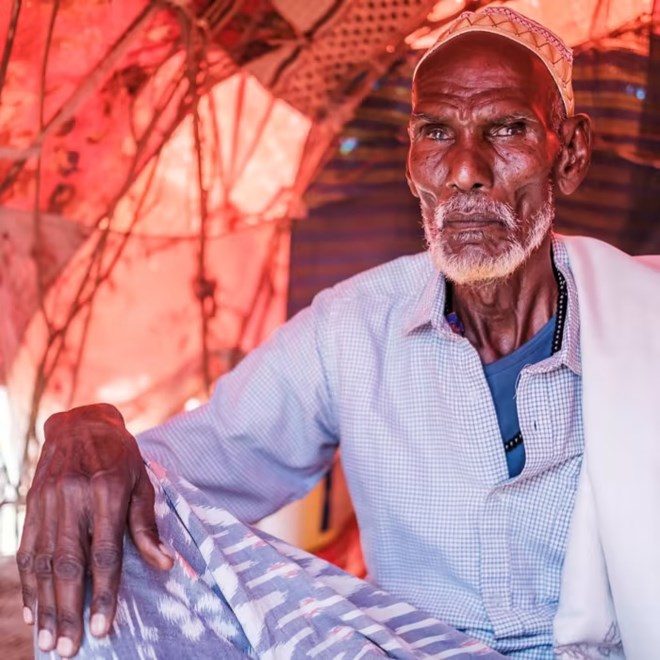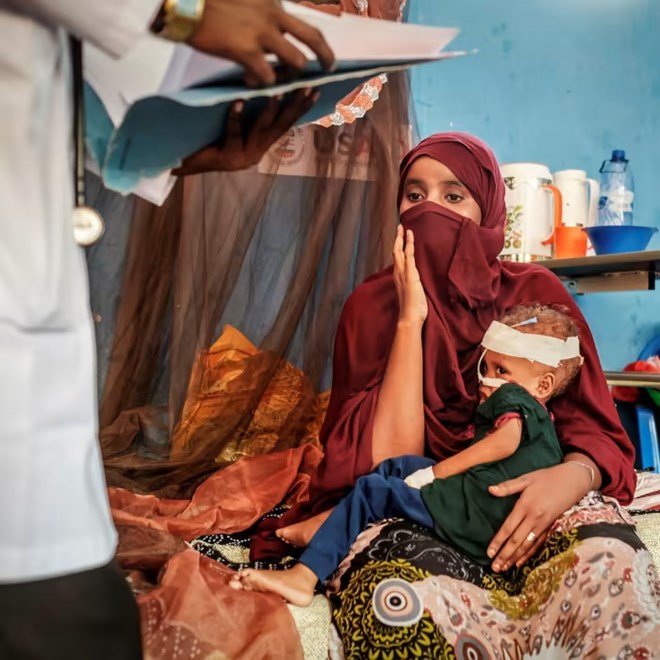
Tuesday May 3, 2022
By Andres Schipani in Gode and David Pilling in Nairobi
Up to 20mn people could go hungry as delayed rains exacerbate fallout from war in Ukraine

Abdullahi Abdi Wali, 99 years old, at this tent at the Higlo camp for Internally Displaced People near the village of Higlo, Ethiopia, on April 27 2022 © Eduardo Soteras Jalil/FT
When the last of his 250 goats died, pastoralist Abdullahi Abdi Wali knew it was time to flee what he calls the “worst drought” in his 99 years of life.
“This is the first time I was displaced by a drought,” he said, looking back on his near-century in south-eastern Ethiopia.
After the death of his animals, Wali walked for five days under a scorching sun to reach a makeshift camp hosting 10,000 Ethiopian pastoralists outside the city of Gode, where they now receive food and water.
In the Horn of Africa as a whole, in an area stretching from northern Kenya to Somalia and swaths of Ethiopia, up to 20mn people could go hungry this year as delayed rains exacerbate what was already the worst drought in four decades.
After three consecutive rainy seasons failed and a fourth looks likely to do the same, crops have disappeared and more than a million livestock have died in Ethiopia’s south-eastern Somali region alone.
One more dry season could turn what is already a disaster into the worst drought in a century, locals say — just as the region is braced for what could be the devastating fallout of war in Ukraine. The conflict threatens not only to increase food prices but also to push the cost of fertiliser beyond the means of millions of farmers, threatening next year’s harvest.
“Globally, we are facing a year of unprecedented needs as conflict, climate shocks and the rising costs of food and fuel leave millions in need of humanitarian assistance,” said Michael Dunford, World Food Programme regional director for eastern Africa.
As temperatures rise globally, food security in the arid and semi-arid parts of the Horn are becoming evermore precarious, experts say. Although droughts are not new, they are becoming more frequent and severe. Since 2008, the area has registered a drought almost every year. In 2011, a famine in Somalia is thought to have killed a quarter of a million people.
Temperatures in parts of the Horn of Africa have scaled record highs. Over the past four decades, rainfall averages have continued to decline, with shorter and shorter rainy seasons.
Now the situation is so severe that local elders in villages in Ethiopia’s Somali region recount stories of half-starved hyenas, monkeys and warthogs attacking under nourished children for food. “We had to move the children to the city to protect them,” said Mohamed Dagane Digabe, a clan elder in the village of Gabia, almost 30km from Gode.
But for many, there may be nowhere to run.
“It is regional so options for migrating to neighbouring areas are not there,” Mustafa Mohamed Omar, president of Ethiopia’s Somali region, told the Financial Times. “Somalia is affected, Kenya is affected, parts of Oromia in Ethiopia are affected. We are sure such a drought is unseen in almost 50 years; people are even saying 100 years.”
The WFP is warning of outright famine in Somalia, where some 6mn people, or 40 per cent of the population, are facing acute food insecurity in a country where jihadi violence is rife. Some analysts say more people are fleeing hunger in the country than violence.
In Ethiopia, which is reeling from a brutal civil war in the northernmost region of Tigray — a conflict that had already left some 9mn people food insecure there and in nearby regions Amhara and Afar — an additional 7mn people now wake up hungry every day in the south and south-east regions, mainly Somali, according to the WFP.
Even in relatively prosperous and stable Kenya, the number of people in need of assistance has risen more than fourfold in less than two years, with drought leaving over 3mn acutely food insecure. “The unpredictable rain for semi-nomadic pastoralism, which supports most people in northern Kenya, makes this increasingly unsustainable.” warned Murithi Mutiga, Africa programme director at Crisis Group in Nairobi. “This will be a huge contributor to instability.”
At a ward dedicated to malnourished children at the general hospital in Gode, where doctors are tending to 2-year-olds who weigh half what they should, Mohamed Abdi Kassa, the medical director, said: “We are expecting more malnourished patients because the drought is not stopping.”
Dunford said: “There is absolutely a crisis unfolding before our eyes across drought-affected parts of the Horn of Africa. In Somalia there is a very real risk that we may see a famine in the coming months if we don’t have rains.” Without adequate funding, he added, humanitarian agencies would not be able to respond if the crisis spread. “People are going to die. It’s as simple as that.”
Over the next six months, the WFP alone estimates it needs more than $470mn to scale up assistance across the three countries. But after the economic cost of Covid, donors — distracted by the war in Ukraine - were unlikely to stump up sufficient funds, experts said. “Nobody’s got any money,” said one diplomat.

Anzel Arab holds her child Maido, 2 years old, as she talks with doctors in the nutrition ward at the Gode General Hospital, in the city of Gode, Ethiopia, on April 28 2022 © Eduardo Soteras Jalil/FT
Aid agencies are running low on crucial wheat stocks from Ukraine and Russia, two of the world’s top producers. In Ethiopia, the WFP and the government procure around three-quarters of the wheat they distribute from those two countries. Wheat prices from the Black Sea have jumped 67 per cent since last year, mainly due to Russia’s invasion of its neighbour.
“Things will get worse, largely because attention is now focused on bigger emergencies in Ukraine and conflict in the north of Ethiopia . . . resources are also going there and food prices are also rising globally,” added Omar.
Halima Mohamed Abdi, a mother of eight who recently settled in another camp outside Gode, is anxious about what lies ahead. “During previous droughts, if we lost the sheep, goats and cows, the camels would survive,” she said. This time, even camels, which generally endure droughts, are dropping dead.
“We are expecting support from government and aid agencies because, even if it rains, we have nothing left,” she said. “Without help, we would also die of thirst and hunger.”